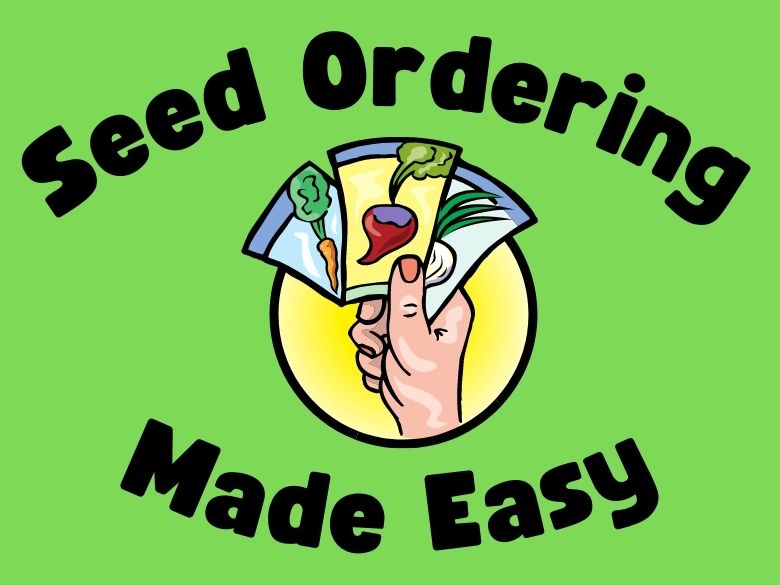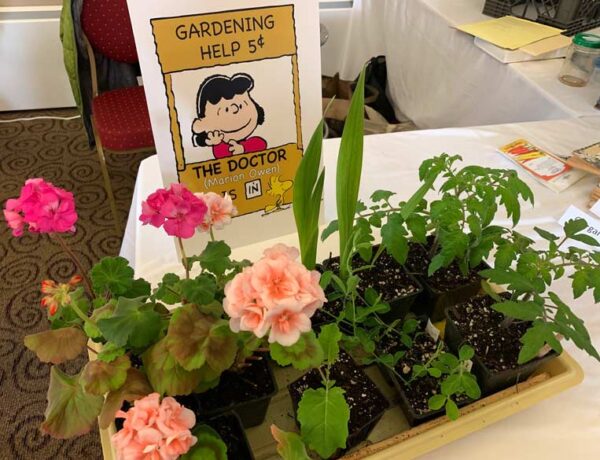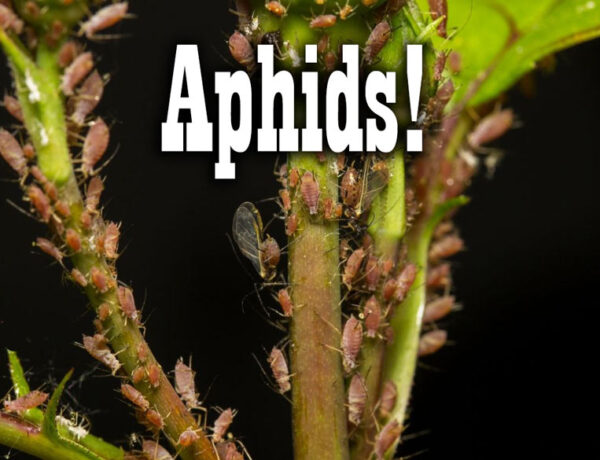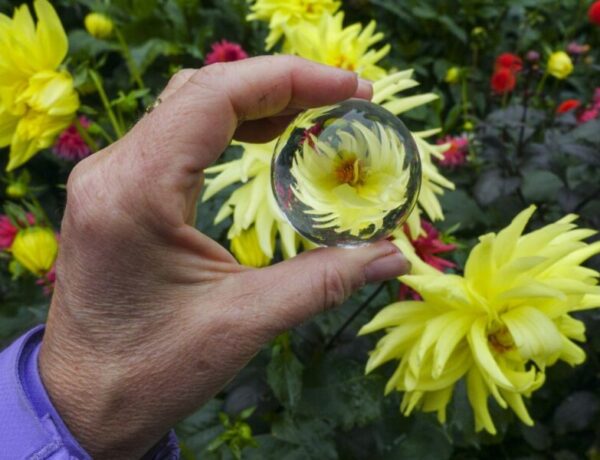It was in the mid-1980s when I ordered seeds for the first time. What a mess! I was totally overwhelmed by all the confusing terms and… mysterious protocols.
- Heirloom varieties?
- Hardening off?
- Companion planting?
Give me a break!So I developed a system, a simple one that took me from overwhelmed to overjoyed. It’s a method I’ve shared for over 30 years with all my gardening classes and workshops.
I must be doing something right because one student later told me, “No more pulling my hair out. Now I look forward to ordering seeds.”
[Hi, it’s Marion. This article was originally published in the Kodiak Daily Mirror, the hometown newspaper for Kodiak, Alaska. Go here to access the archive page for the list of my past columns, written each week since 1986].
Let’s give it a go, shall we?
Step #1: Gather Your Tools
Arrange the following tools on a table:
- Seed catalogs
- Computer or smartphone
- Pad of lined paper
- Pencil or pen
- You might be wondering, a pad of paper? What gets written, gets remembered.
Plus, I find it helps to write things out on paper before placing orders online. I call it a pre-order. More on that in a minute…
Step #2: Make a List
Have a conversation with yourself!
- What do you like to eat?
- What are our favorite flowers?
- Do you want fresh herbs to cook with?
- Review last season:
- What worked?
- What didn’t? (Ask yourself why so you can fix it)
Take a seed inventory:
We’re all guilty of going to the store and buying food, only to realize later that we already had it!
Do you have seeds leftover from previous years? If so, how old are they? Seeds are alive and they have a shelf-life. For example:
- Onions and voila: 1 year
- Broccoli and cilantro: 3-5 years
- Lettuce and nasturtium: 5-6 years
Step #3: Make a Pre-Order of Your Seed Order
Don’t skip this step!
Your pre-order is a draft order which streamlines the entire process. This means you’re on the way to stress-free seed ordering.
Grab your pad of paper…
- On the left side, create a column, write main categories, such as broccoli.
- Under each category, list varieties. In this case, varieties of broccoli such as Arcadia or Packman.
- Across the top, make a column for each catalog.
Now as you flip through catalogs or visit websites, write the page number and price (optional) for the variety in the catalog column.
PRO TIP: Several companies might offer Arcadia broccoli, but now you know where to find it. This is handy when you go back to compare pricing, how many seeds are in a packet, costs, days to maturity, and so on.
Research. Write. Repeat.
Step #4: Before Submitting Your Seed Order…
As you research keep the following parameters in mind. They will help you select the right seeds for your growing conditions and climate…
a) Which ‘Plant Hardiness Zone’ are you in?
Plant Hardiness Zones, as they’re called in the US, are not a perfect science. Sometimes when I conducted workshops at the prestigious Seattle and San Francisco Flower and Garden Shows, I was the curiosity from Alaska and was often asked, “What’s zone are you in?” Sometimes I’d reply with, “The ozone,” and the audience would chuckle.
Hardiness Zones are meant to be the standard by which gardeners and growers determine which plants are most likely to thrive at a location. From my experience, these zones are moving targets, thanks mostly to micro-climates and climate change.
For example, you might live in Zone 4, but your garden faces south so it benefits from full sun and no shade. You might be able to grow varieties listed as Zone 5 or 6.
If you’re not sure which Plant Hardiness Zone you’re in, Google “USDA Plant Hardiness Zone Map.” Enter your zip code, address or location in the search bar in the upper left. Then compare the colors in the map to the legend on the right.
How are the zones created, anyway?
According to the US Department of Agriculture, the map (updated in 2012) is based on the average annual minimum winter temperature, divided into 10-degree F zones.
Remember, it’s not perfect science here. When I entered our zip code of 99615 for Kodiak, Alaska, the map placed us in Zone 6a (6a (-10 to -5 °F/-23.3 to -20.6 °C.
Same zone as Louisville, Kentucky and Carson City, Nevada!
Crazy!
A. Be aware of pest and disease resistance:
Catalogs are getting better at listing which varieties are prone to certain pests and diseases. After all, seed companies want you to be successful and come back for more. For example: Potatoes (scab), lettuce (gray mold), summer squash (blossom end-rot, tomatoes (fusarium wilt)
B. Check for days to maturity:
This is the time from sowing seeds to when you can expect to begin harvesting.
C. Decide on plant parenting:
How important is it to you if the seed is open-pollinated (OP), hybrid (F1, etc.), GMO, heirloom, or organic?
D. Seed characteristics:
Are they annuals, perennials, or biennials? Treated or pelletized? Read the fine print to avoid surprises.
E. Ask for guidance:
Gardening is not an exact science. Get on forums or Facebook groups. Ask questions. Talk to local gardeners.
Step #5: Place Your Order:
Here’s where the beauty and power of your pre-order come in.
Refer to it as you shop online or fill out the paper form. There is such freedom in doing something with a clear mind!
BONUS! Guide to Some of My Favorite Seed Catalogs
Here is a list of my favorite seed catalogs. (Your climate and day length might require other sources):
Fedco
Johnny’s Selected Seeds
Territorial Seeds
Baker Creek Heirlooms
Stokes
Parks
Harris Seeds
Renee’s Garden Seeds
Pinetree Garden Seeds
If you’re new to garden catalogs (print and online), don’t be discouraged by the enchanting photos in the catalog. They’re taken at peak perfection. So if your plants don’t look quite like the pictures, keep trying — that’s what gardeners do best.
Finally, while growing your own seedlings is a rewarding challenge, we have in Kodiak a rare find in the form of a local nursery called Rooted. That’s because worldwide, the industry has moved away from local plants and now depend on mass, regional growers as their seedling suppliers.
Support local!
I’ll see you next week.

Here are more resources for you:
Hi gardeners! Want to create your dream garden? You can do it, step-by-step with Marion Owen: The Gardener’s Coach. Visit my YouTube channel: The Gardener’s Coach.
Compost is the answer to everything in the garden!
And if you have enough of it, you won’t need much of anything else. To learn more, take my 60-second assessment.





1 Comment
Christmas in Kodiak, Alaska | Alaska gardening column | Marion Owen
June 13, 2022 at 9:46 PM[…] Speaking of simplicity, here is a simple method to order seeds online or from a catalog. […]